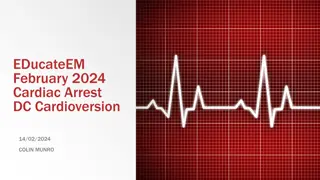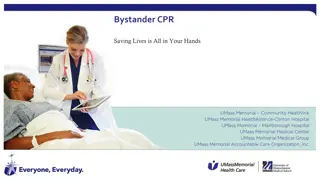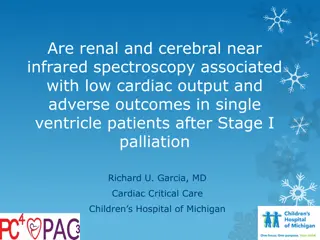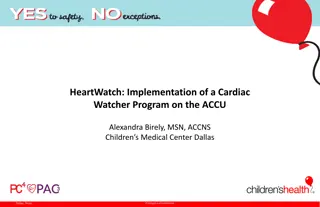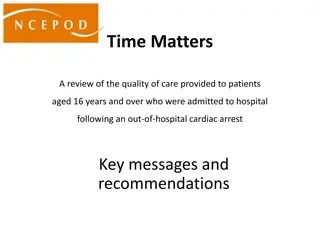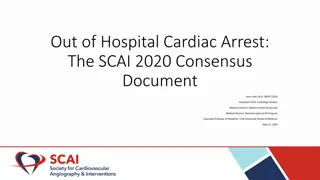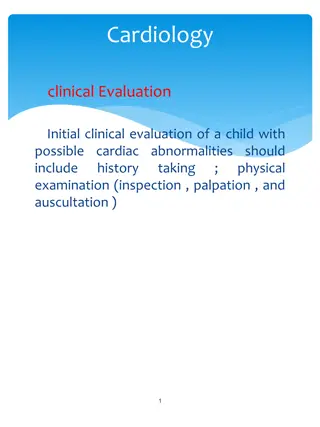ARREST Trial: Expedited Transfer for Non-ST Elevation OHCA
This prospective, multicentre, randomised clinical trial led by Dr. Tiffany Patterson aims to determine whether direct delivery to a cardiac arrest centre following non-ST elevation out-of-hospital cardiac arrest reduces deaths compared to delivery to the nearest emergency department. Funded by the
0 views • 17 slides
Effective Strategies for DC Cardioversion in Cardiac Arrest Management
Understanding the indications for DC cardioversion, preparing the environment and equipment, knowledge of defibrillator use, and post-cardioversion care are crucial steps in managing cardiac arrest cases. This educational material provides a comprehensive guide on when to intervene, how to prepare,
0 views • 8 slides
Bystander CPR: Steps to Save Lives & Facts About Cardiac Arrest
Learn the importance of bystander CPR in saving lives during sudden cardiac arrest incidents. Understand the steps to perform hands-only CPR, identify compression rates, and the role of the Good Samaritan law. Discover key facts about sudden cardiac arrest and how bystander intervention can signific
1 views • 13 slides
Acoramidis Improves Cardiac Function in Transthyretin Amyloid Cardiomyopathy
Acoramidis, a next-generation TTR stabilizer, shows promising results in improving cardiac function and promoting regression in Transthyretin Amyloid Cardiomyopathy. The ATTRibute-CM Cardiac Magnetic Resonance Substudy evaluated changes in cardiac structure, function, and amyloid burden after treatm
0 views • 8 slides
Expert Recommendations for Out-of-Hospital Cardiac Arrest Management
Out-of-hospital cardiac arrest (OHCA) is a significant public health concern with high mortality rates. This expert consensus statement led by Dr. Amir Lotfi provides evidence-based recommendations for managing OHCA patients with shockable rhythms and return of spontaneous circulation (ROSC), aiming
0 views • 10 slides
Cardiac Output and Venous Return in Cardiovascular Physiology
Cardiac output, stroke volume, end-diastolic and end-systolic volumes play vital roles in cardiovascular function. Factors affecting cardiac output include physiological conditions and pathological states like hyperthyroidism and myocardial infarction. Venous return, controlled by mechanisms like Fr
0 views • 27 slides
Association of Renal and Cerebral Near-Infrared Spectroscopy with Adverse Outcomes in Single Ventricle Patients after Stage I Palliation
Study investigates the association between renal and cerebral near-infrared spectroscopy (NIRS) values and low cardiac output syndrome in single ventricle patients post Stage I palliation. Data from infants who underwent surgery between 2010-2019 is analyzed to determine correlations with adverse ou
1 views • 13 slides
Cardiac Electrical Activity in Physiology Team's Cardiovascular Block Lecture
Dive into the intricate details of cardiac electrical activity in this lecture led by Physiology Team 436. Explore topics like the cardiac conductive system, action potentials, refractory periods, excitation-contraction coupling, and the effects of autonomic stimulation on heart electrophysiology. D
0 views • 29 slides
Implementation of Cardiac Watcher Program in CMC Dallas
Twofold increase in sudden cardiac arrests on the ACCU prompted the implementation of the Cardiac Watcher Program in Children's Medical Center, Dallas. The program aims to decrease cardiac arrests by improving patient identification and creating a shared mental model among team members. Developed pa
0 views • 9 slides
Bystander CPR: Steps to Save Lives During Cardiac Arrest
Learn how to perform hands-only CPR effectively in case of cardiac arrest. Understand the importance of quick action, proper compression rate, and the Good Samaritan law. Discover facts about sudden cardiac arrest and why bystander CPR can significantly increase survival rates. Follow a guide on wha
0 views • 13 slides
Association of Renal and Cerebral Near Infrared Spectroscopy with Low Cardiac Output in Single Ventricle Patients
Near-infrared spectroscopy (NIRS) has been studied in infants after Stage I palliation surgery to assess its association with low cardiac output and adverse outcomes. This retrospective study investigated postoperative cerebral and renal NIRS values in infants with single ventricle physiology. Resul
0 views • 13 slides
Cardiac Glycosides in Pharmacognosy and Phytochemistry
Explore the role of Steroids, Cardiac Glycosides, and Triterpenoids in pharmacognosy and phytochemistry, focusing on their general introduction, composition, chemistry, biosources, therapeutic uses, and commercial applications. Learn about the structure and attachment of sugar parts in Cardiac Glyco
9 views • 9 slides
Pathophysiology of Cardiac Failure and Adaptive Mechanisms of the Heart
Cardiac failure is a condition where the heart is unable to meet tissue metabolic needs despite normal or increased venous return. Causes include decreased contractility, coronary blood flow, damaged valves, and more. Normal resting cardiac output is 5 Lt/mts, with adaptive mechanisms like the Frank
1 views • 35 slides
Canadian Cardiac Transplant Network Status Review 2021
The Canadian Cardiac Transplant Network Status Review 2021 provides a detailed overview of cardiac transplant programs across various provinces in Canada from 2016 to 2021. The report includes data on the number of cases, hospitals involved, and referral centers, showcasing the trends in cardiac tra
1 views • 59 slides
Enhancing Cardiac Arrest Survival Through Dispatcher-Assisted Bystander CPR
This presentation emphasizes the importance of dispatcher-assisted bystander CPR in identifying pulseless, non-breathing patients to improve cardiac arrest survival rates. Highlighting the need for community involvement, it showcases the impact of prompt response and effective CPR on increasing surv
0 views • 10 slides
European Arrest Warrants and Legal Framework in European Criminal Law
Description of two cases involving European Arrest Warrants - one for theft in Hungary and the other for driving without a license in Romania. The cases raise preliminary questions about the execution of European Arrest Warrants and detention conditions in issuing Member States.
0 views • 20 slides
Sudden Cardiac Arrest: Facts, Statistics, and Treatment
Sudden cardiac arrest is a critical condition where the heart suddenly stops beating, leading to a lack of blood flow to vital organs. Learn about the definition, statistics, importance of early CPR, and treatments for sudden cardiac arrest to increase survival rates. Bystander participation in perf
0 views • 13 slides
Enhancing Post-Cardiac Arrest Resuscitation Care
Learn about interventions to improve survival and neurological recovery post-cardiac arrest. Discover key aspects of successful post-arrest care and eligibility for interventions reducing brain injury. Includes priorities, clinical cases, prehospital care, stabilization, and identification of treata
2 views • 33 slides
Critical Cardiac Arrest Patient Nursing Scenario
In this scenario, you are starting your shift in the ICU with a critical cardiac arrest patient, Jack Prescott, a 56-year-old male. The learning objectives include recognizing septic patient symptoms, assessing hemodynamic status, initiating communication with a physician, and developing a care plan
0 views • 12 slides
The Washington State Patrol's Notice of Arrest Process
The Washington State Patrol's Notice of Arrest (NOA) is crucial for verifying the accuracy of arrest information, confirming a person's identity through fingerprint comparison, and identifying any outstanding warrants or protection orders. The process involves fingerprint identification, the issuanc
1 views • 15 slides
Thrombolytics in Cardiac Arrest from Pulmonary Embolism: Evidence Review
Thrombolytics are suggested for cardiac arrest from presumed PE despite lack of RCTs focusing on this subset. Studies on undifferentiated cardiac arrest did not show a survival benefit. Trials using tissue plasminogen activator in PEA arrest showed no significant difference in outcomes, while a stud
0 views • 13 slides
Improving Cardiac Arrest Survival Rates Through Dispatcher-Assisted Bystander CPR Training
This project aims to increase cardiac arrest survival rates by training dispatchers to assist bystanders in providing CPR to patients who are pulseless and not breathing. By bringing dispatcher-assisted CPR to Milwaukee County, the goal is to enhance bystander CPR rates and ultimately improve cardia
0 views • 28 slides
Sudden Cardiac Arrest (SCA) and AEDs
Sudden Cardiac Arrest (SCA) is a life-threatening condition where the heart suddenly stops beating, leading to death if not treated promptly. It can occur without warning signs and affects both children and adults. Automated External Defibrillators (AEDs) play a crucial role in providing immediate t
0 views • 10 slides
Sudden Cardiac Arrest in Intercollegiate Athletics: Are You Prepared?
Sudden Cardiac Arrest (SCA) is the leading cause of death in college athletes, emphasizing the importance of prevention and preparedness. Pre-participation evaluations, common causes of SCA, and emergency action plans are crucial in ensuring a timely response to SCA incidents, which may manifest in
0 views • 11 slides
Quality of Care for Patients Following Out-of-Hospital Cardiac Arrest
This review focuses on the quality of care provided to adult patients aged 16 years and older who were admitted to the hospital after experiencing an out-of-hospital cardiac arrest. Key messages highlight the importance of strategies for rapid and high-quality resuscitation, documentation of advance
0 views • 24 slides
Management Recommendations for Out-of-Hospital Cardiac Arrest Patients
Out-of-hospital cardiac arrest (OHCA) is a critical public health issue with high mortality rates. This consensus document by Dr. Amir Lotfi provides evidence-based recommendations for managing OHCA patients, particularly focusing on those with shockable rhythms and return of spontaneous circulation
0 views • 18 slides
Cardiopulmonary Resuscitation (CPR) and Cardiac Arrest
Cardiopulmonary resuscitation (CPR) is crucial in cases of cardiac arrest, a leading cause of death globally. Immediate recognition of symptoms such as unresponsiveness and abnormal breathing, early activation of emergency services, and prompt initiation of CPR can significantly improve survival rat
0 views • 23 slides
Modes of Execution of Decree in Civil Law
The lecture discusses the various modes of execution of decree in civil law, such as execution against a person through arrest and detention, and execution against property. It explains the procedures involved in arrest and detention, including the conditions for release, restrictions on arrest, and
0 views • 9 slides
Comprehensive Clinical Evaluation of Children with Cardiac Abnormalities
Initial clinical evaluation of a child with possible cardiac abnormalities includes history taking and physical examination. History should cover symptoms related to pulmonary and systemic venous congestion, cyanosis, cyanotic spells, palpitations, chest pain, and more. The general physical examinat
0 views • 65 slides
Importance of CPR in Cardiac Arrest Emergencies
CPR is crucial in cardiac arrest situations as it can prevent brain damage and increase the chance of survival. Knowing how to check for responsiveness and perform CPR correctly on adults, children, and infants can make a difference in saving a life. Immediate action within the first few minutes is
0 views • 10 slides
Cardiac Action Potential: Ionic Basis and Excitability in Cells
Explore the complex processes underlying cardiac action potential, from ionic equilibrium to resting membrane potential and excitability in cardiac cells. Learn about the critical thresholds, equilibrium potentials, and gradients that regulate the electrical activity of the heart. Discover the intri
0 views • 68 slides
AIRWAYS-3 Trial: Advanced Airway Management in In-Hospital Cardiac Arrest
AIRWAYS-3 is a multi-centre, open-label, randomized trial evaluating the clinical and cost effectiveness of a supraglottic airway (SGA) versus tracheal intubation during in-hospital cardiac arrest (IHCA). The trial aims to determine the functional status and health-related quality of life outcomes o
0 views • 9 slides
Loss of Consciousness and Sudden Cardiac Death in Children
Loss of consciousness, including syncope and sudden cardiac death, is a significant concern in pediatric patients. The epidemiology shows that approximately 25% of children experience at least one episode of loss of consciousness before the age of 19, with girls visiting pediatricians more than boys
0 views • 5 slides
Precision Medicine Approach for Post-cardiac Arrest Care Study
Study aims to develop novel biomarkers for optimizing hypothermia duration post-cardiac arrest and predicting 90-day function. Overcoming past limitations in neuroprognostication research, the study utilizes a multicenter approach and standardizes post-resuscitation care protocols. Addressing challe
0 views • 13 slides
Management of Cardiac Emergencies and Injuries: Guidelines and Updates
This document provides detailed information on managing cardiac emergencies and injuries, including bradycardia, tachydysrhythmias, and cardiac arrest in adults and children. It outlines specific interventions such as atropine, adrenaline, and synchronized cardioversion, with changes in protocols an
0 views • 15 slides
Hawkesbury Defib Project - Saving Lives Through Defibrillators
Hawkesbury Defib Project, led by Andrew White, aims to educate and empower communities about the importance of early defibrillation in saving lives from sudden cardiac arrest. With thousands of out-of-hospital cardiac arrests occurring yearly, the initiative focuses on raising awareness and ensuring
0 views • 13 slides
Sudden Cardiac Arrest and Prevention Measures
Sudden Cardiac Arrest (SCA) is a life-threatening event that occurs without warning due to electrical malfunctions in the heart. The condition can lead to loss of consciousness and death within minutes if not treated promptly. This training program covers CPR/AED techniques, key components of CPR, a
0 views • 39 slides
Cost-Effectiveness Analysis of Out-of-Hospital Cardiac Arrest Management Strategies
Out-of-hospital cardiac arrest (OHCA) poses a significant health challenge with a low survival rate. This study evaluates the cost-effectiveness of immediate angiography and PCI compared to standard care for OHCA patients. Decision tree modeling and sensitivity analyses were used to assess the econo
1 views • 12 slides
The Washington State Patrol Notice of Arrest
Explore the significance of reviewing the Notice of Arrest issued by the Washington State Patrol (WSP). Learn how to verify arrest information accuracy, confirm identities through fingerprint comparison, and discover outstanding warrants or protection orders associated with individuals. Find out how
0 views • 15 slides
Emergency Management in Cardiac Intensive Care
Information on managing emergencies in cardiac intensive care including topics like hemorrhage post-cardiac surgery, tamponade post-cardiac surgery, and control of bleeding. Details on initial steps for bleeding control, teamwork in managing hemorrhage, and diagnosing tamponade post-cardiac surgery
0 views • 16 slides

